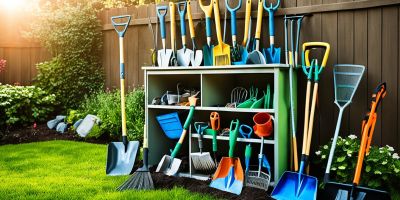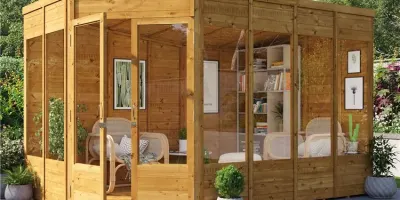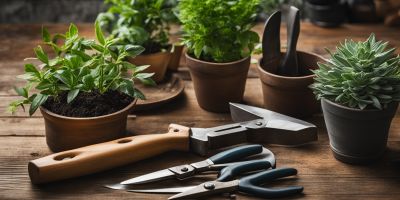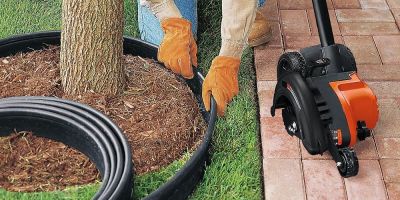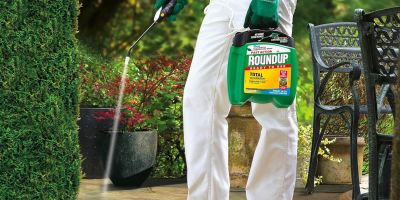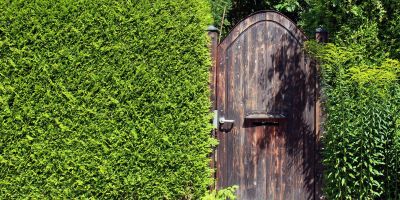2024-08-22 13:20:15 |
Turning your garden into a neat lawn is easier than you think. A garden edger is key for perfect edges, making your garden look professional. It helps tidy up borders or create new ones, giving you clean, sharp edges every time. This makes your garden look better and more structured.
The Black amp; Decker Edge Hog is a great example. It costs less than £100 and can handle up to 5,000 linear feet of edging on a big property. It makes edges with a neat 1½ inches depth.
The CORE EDGE is made in Britain from strong 1.6mm steel and has a durable zinc coating. It comes with five strips for five meters of edging. Its 110-micron polyester coating means it can stand up to the outdoors, keeping your garden edges looking great.
Key Takeaways
- Using a garden edger can greatly improve your garden's look.
- The Black amp; Decker Edge Hog is a budget-friendly choice for big lawn edges.
- CORE EDGE offers top-quality edging solutions made in the UK.
- A garden edger makes it easy to get a professional finish with little effort.
- Regular care means your lawn edges will stay neat and attractive.
Getting Started with Your Garden Edger
Getting the perfect lawn edges starts with the right tools and a tidy workspace. Whether you're starting new lawn edges or keeping up with the old ones, having the right tools and setting up right is key. This guide will show you how to begin with your garden edger effectively.
Essential Tools for Lawn Edging
For lawn edging, the right essential tools make a big difference. Here are some top picks for a neat finish:
- Half-moon edger: Great for straight edges with precision.
- Edging shears: Ideal for small lawns.
- Long-handled grass shears: Perfect for easy and efficient trimming.
- Spiked metal sheeting: A simple way to define lawn edges.
For big lawns, think about getting an electric garden edger or a grass trimmer with an edging feature. These tools have depth control, wheels for straight lines, and telescopic handles for comfort. Cordless models are handy but might cost more than plug-in ones.
Setting Up Your Workspace
Before starting, plan out the areas you want to edge. Use a string line for straight edges or a garden hose for curves. Make sure your workspace is ready for lawn edging by clearing debris and leveling the ground.
For easy and neat garden edges, FlexiBorder is a great choice. It's made from recycled rubber, comes in various colours, and works well with lawn mowers. You can cut it to size with a handsaw and secure it with quality pegs.
Benefits of Using a Garden Edger
Using a garden edger brings many benefits, like getting a clear and precise lawn edging. This makes your garden look better. It also makes garden maintenance easier.
Edging stops weeds from spreading by acting as a barrier. It keeps them out of your grass. This means you won't have to weed as much.
It also keeps your flower beds safe from being trampled. This helps your plants stay healthy and keeps pests away. Edging acts as a shield for your plants.
Edging your lawn can also make your property more valuable. It makes your garden look inviting to potential buyers. Spring is a great time to start edging to keep your garden neat all season.
If your grass is growing over your driveways or sidewalks, it's time to edge. This keeps your garden looking tidy.
How often you edge depends on how fast your grass grows and how tidy you like things. If you see grass getting into your pathways or need to mow often, it's time to edge. A professional edger can cut up to 10mm off the edge, keeping it neat.
When edging, press it down firmly so it stays in place. You can use different materials for the edging, fitting any style or budget. The colour of the edging can also match or contrast with your plants, making your garden look better.
Types of Garden Edgers: Electric vs Manual
Choosing the right garden edger can make a big difference in your lawn's look. Let's look at the benefits of electric garden edgers and manual lawn edgers.
Electric Garden Edgers
Electric garden edgers are great for those who want a quick way to keep their lawn edges neat. The Greenworks Pro 80V 8-Inch Brushless Lawn Edger is a top pick, priced at $200 on Amazon. It's powerful yet light, weighing 16.57 lbs and cutting up to 1.75 inches deep.
The WORX 12-Amp 7.5-Inch Electric Lawn Edger amp; Trencher is another great option. It's only 14 lbs and costs $98, making it a budget-friendly choice. The Stihl KMA 80 R is also efficient, weighing 15.4 lbs and priced at $500, thanks to its lithium-ion batteries.

Manual Lawn Edgers
Manual lawn edgers are perfect for those who like a hands-on approach. They're simple to use and don't need much upkeep. The AMES 2917200 Saw-Tooth Border Edger with T-Grip is a great choice, weighing just 3 lbs and priced at $59 at Walmart.
The Echo PE-225 Handheld Edger offers strong performance, weighing 20 lbs and cutting up to 7.75 inches deep, for $316 on Amazon. These manual edgers give you control over your lawn, making every edge satisfying.
Which One is Right for You?
Deciding between electric and manual garden edgers depends on what you need and like. If you have a big garden and want quick maintenance, an electric edger might be best. Tools like the Greenworks Pro 80V 8-Inch Brushless Lawn Edger and WORX 12-Amp 7.5-Inch Electric Lawn Edger amp; Trencher are efficient and easy to use.
For smaller gardens or if you prefer a hands-on approach, manual lawn edgers are ideal. Tools like the AMES 2917200 Saw-Tooth Border Edger or the Echo PE-225 Handheld Edger offer precision and control. They're also quieter and need less maintenance.
Think about your garden's size, your strength, and what you prefer in an edger. Whether you pick an electric or manual edger, a well-maintained lawn edge will improve your garden's look.
Creating a New Lawn Edge
Creating a new lawn edge is key to a well-planned garden. It makes your garden look better and helps define different areas. Garden planning and marking out are vital steps for a professional finish.
Planning Your Lawn Edge
Start by thinking about your garden's layout and purpose. Whether it's big or small, aim for neat borders that look good and serve a purpose. Experts say to keep flower beds or borders about 3ft deep to let plants grow well and make upkeep easy.
Spring is the best time to do this, as it's great for grass growth. It lets new lawn edges grow strong before the summer heat hits.
Think about how much sun each plant needs when planning your garden. Some love full sun, while others prefer shade. This ensures your plants do well in their spots. Also, beds wider than 50cm are better for stepping into, but they can be harder to maintain.
Using grass marking paint to draw your borders is a smart move. It makes your new edges clear and easy to see.
Marking Out Your Desired Lines
Marking out your lawn's new lines is the next step. A manual half-moon edger is great for making clean cuts. You can use hoses, strings, or paint to mark where you want your edges to be.
Trimming your lawn edges regularly is important in spring and autumn. You might need to do it every week. Use long-handled shears from the lawn to cut back any straying blades. Keeping up with this will keep your lawn edge looking sharp.
Re-Creating and Maintaining Existing Edges
Keeping your lawn edges tidy is very rewarding and keeps your garden looking sharp. Using lawn edging materials like plastic, metal, stone, or wood helps avoid hazards and makes them last longer. Refreshing your garden edges can greatly improve its look, making it seem more put together.
Tools for Edge Maintenance
It's crucial to have the right tools for edge maintenance. Here are some must-have tools:
- Half-Moon Edger: Great for making clean cuts, works well for both curved and straight edges.
- Flat-Backed Spade: A versatile tool that can act as a garden edger, ideal for fixing existing edges.
- Long-Handled Shears: Perfect for trimming edges weekly without straining your back.
- Steps to Refresh Your Edges
Refreshing your garden edges is easy but makes a big difference. Here's how to do it:
- Inspect and Prepare: Check the edges for any damage. A clean edge is key for easy upkeep.
- Clean the Edges: Use a spade or half-moon edger to trim back grass and define the border. For metal edging, keep lines straight; for plastic, try wavy edges if you like.
- Use Mulch: Mulching adds beauty and prevents weeds. Aim for a 3ft depth when planting or redefining beds.
- Weekly Trimming: Trim edges regularly with long-handled shears in spring and early autumn to keep them looking great.
For the best lawn edges, cut them back every year, especially on light, sandy soil. This keeps the edges looking good and makes mowing and edging easier.
If grass keeps creeping into your lawn, consider using permanent lawn edging. Wooden edges offer a softer look, while lights and unique materials can add creativity. Metal is best for straight lines, and plastic is great for wavy edges. With these steps and the right tools, keeping your lawn edges in top shape will be easier and more fun.
Step-by-Step Guide to Using a Garden Edger
Creating perfect garden edges is an art. The right steps lead to a flawless result. This guide will help you achieve clean, sharp lines. These lines add a professional touch to your garden.
Step 1: Mark Out Your Line
Start by planning your new edge. Use a garden hose or string to mark the line. Make sure it follows your garden's natural shape for the best look. A marked line helps guide you when cutting.
Step 2: Cut the Edge
Use your garden edger along the marked line. If you have an electric stick edger, set the blade depth to about 2 inches (5.1 cm). This controls the grass roots. Cut steadily for an even edge.
Step 3: Remove the Turf
After cutting, remove the turf along the line. Scoop out the soil to create a trench. This defines your garden edges well. For big areas, consider a manual or wheeled edger if you can afford it.
Step 4: Hone the Edge
Refine the edge with hand shears or an electric weed whacker. Trim any stray grass on the lawn edges. Clear cut grass every 5–6 feet to keep the edge straight.
Step 5: Mulch the Bed
Finally, mulch the bed in the trenches. Mulching keeps the soil healthy and moist. It also makes your garden look great.
Follow this garden edger guide for neat, pleasing garden edges. Your garden will look amazing.
Creating Curved Garden Edges
Creating curved garden edges can make your garden look more inviting. Curved lines are softer and more natural than straight edges. This makes your garden look more cohesive and welcoming. We'll look at two main ways to get these elegant curves: using a hose or rope for marking and making sure the curves are smooth.
How to Use a Hose or Rope for Curved Lines
A simple way to get curved garden edges is by using a hose or rope. This lets you see how the curves will look before digging. Just lay a hose or rope on the ground to mark the edge path. Adjust it until you like the curve's flow. This way, you can try out different designs to find the best one.
- Lay down a hose or rope to mark out the desired curved lines.
- Adjust the hose or rope to test different designs.
- Ensure the curves are smooth and natural-looking.
- Once satisfied, use spray paint or flour to mark the lines permanently.
Ensuring Smooth Curves
After marking your curved garden edges, make sure they're smooth and look natural. Smooth curves help your garden flow well together. Here are some tips for smooth curves:
- Use a shovel to follow the marked lines, cutting cleanly and evenly.
- Avoid sharp angles that can disrupt the curve's flow.
- For consistent curves, use a flexible piece of wood or a plastic edge guide.
- Regularly step back and view your work from different angles to ensure the curved lines blend well with the landscape.
Creating curved garden edges takes patience and care, but it's worth it. Whether you choose natural curves with a hose or go for concrete borders, these tips will help you get smooth, beautiful lines. These lines will make your garden look better.
Utilising FlexiBorders for Circular Designs
Circular garden designs can bring a touch of elegance to your garden. FlexiBorders, crafted from recycled rubber, are an eco-friendly choice for outlining these beautiful shapes. They make it easy to create neat circular edges around trees and shrubs.
Installing FlexiBorders
Start by tracing the circle where you wish to place your garden design. Use a string tied to a central point for accuracy. Once the circle is marked, you can begin installing FlexiBorders along the line. These borders come in various colours, so pick one that suits your garden's look.
Creating Perfect Circular Edges
After installing the FlexiBorders, focus on achieving those flawless circular edges. Symmetry in your garden can make it look more balanced and elegant. FlexiBorders make this symmetry easy to achieve. They're versatile, used in sports areas, playgrounds, and street plantings.
For a balanced look, pair small trees with larger ones. FlexiBorders help create smooth transitions between garden areas. This product is chosen for its beauty, ease of upkeep, safety, and durability.
FlexiBorders Features Benefits
Available in multiple colours Helps match garden aesthetics
Made from recycled rubber Eco-friendly and sustainable
Used in various applications Versatile for different spaces
Easy to install and maintain Convenient for homeowners

Tools and Accessories for a Perfect Lawn Edge
Getting your lawn edge just right needs the right tools and accessories. Half-moon edgers, flat-backed spades, and hand shears are key for a sharp, clean look. Let's explore how each tool helps make your garden edge perfect.
Half-Moon Edgers
Half-moon edgers are vital for precise lawn edging. Their curved blade cuts through soil easily, making it easy to set clear lines between lawn and flowerbeds. Bulldog has been making strong half-moon edgers for almost a hundred years, promising both durability and results.
Flat-Backed Spades
Flat-backed spades are great for trenching and edging. They're perfect for straight lines and deep edges. The Bahco P75 model is known for its strength and reliability, leading the way in edging spade design.
Hand Shears
Hand shears are ideal for fine-tuning edges made by other tools. They're great for detailed work around trees and sheds. The Bahco P74 and Wilkinson Sword models offer top-notch quality at various price points.
Tool Type Recommended Brand Key Features
Half-Moon Edgers Bulldog Durable, Precise Cuts
Flat-Backed Spades Bahco P75 Strength, Reliability
Hand Shears Bahco P74, Wilkinson Sword Detail Work, Budget-Friendly
Tips for Maintaining Your Lawn Edger
Looking after your lawn edger well is key to its best performance and long life. Here are some top tips to keep your garden tool in great shape.
Cleaning and Storage
It's vital to keep your lawn edger clean to stop rust and keep it working well. After each use, clear off any soil and grass clippings from the blades and parts. Use a stiff brush to clean off any leftovers and make sure the metal is dry.
When storing, make sure the edger is dry first. Put it in a dry, safe place. Using a shed or tool rack is a good idea too.
Sharpening Blades
Sharp blades mean clean cuts and less strain on the edger. Check the blade's sharpness often and sharpen it with a stone or file if needed. Always follow the maker's sharpening guide to avoid mistakes.
Sharpen the blades every few months, based on how often you use it. Sharp blades mean a neat cut, which is good for your lawn's health and look. Don't use the edger on rocky ground as it can dull the blades quickly.
Regular Maintenance Checks
Do regular checks on your lawn edger, looking at moving parts, bolts, and its build. Watch for wear and tear, like loose parts or odd noises.
Use oil on moving parts to keep them running smoothly and to stop rust. Doing these checks often helps keep your edger working well and safely.
By looking after your lawn edger with regular cleaning, sharpening, and maintenance checks, you'll have a garden with neat edges.
Garden Edger: A Must-Have for Garden Enthusiasts
For any garden enthusiast aiming for lawn perfection, having the right tools is key. The garden edger is a top choice. It makes clean edges between your lawn and flower beds, giving your garden a professional look with ease.
Garden edgers are easy to use and very effective. The Flymo corded strimmer is a great pick, with 500W power and a 25cm cutting width. It cuts efficiently. If you prefer cordless, the Powerbase 577172 is a top choice, weighing only 2.7kg and easy to use.
When picking a garden edger, consider its price. It's usually around £28.98, a good deal for its quality. These edgers are also not too heavy, making them easy to use. Brands like Spear amp; Jackson get a lot of praise, with 97% of customers happy with their edging shears.
Some edgers come with adjustable handles, like the Darlac edgers. They adjust from 67-108cm, fitting different heights and easing garden work. Cordless options like the Ryobi strimmer last up to 50 minutes, giving you plenty of time to edge without needing to recharge.
In conclusion, a garden edger is essential for every gardening enthusiast. It makes your garden look great and is easy to use. With it, you can easily keep your lawn perfect, making your garden a joy to behold.
Conclusion
Choosing the right garden edger is key to perfect lawn edges. This article covered important points to help you pick wisely. We looked at electric and manual garden edgers, and the importance of the right tools and accessories.
Manual lawn edging is great for small to medium lawns because it's affordable. However, it takes more work and upkeep. Electric or battery-powered edgers are better for big lawns and those who want less hard work. It's all about matching your needs with the right edger type.
Adding a garden edger to your tools makes your lawn look better and helps with soil care and preventing erosion. Metal garden edging is very durable and easy to maintain. It keeps your lawn looking neat and supports healthy plants. Whether you're experienced or new to gardening, getting a garden edger is a smart move. It helps keep your garden looking great for a long time. Follow these tips and watch your garden grow with precision and care.
FAQ
What are the essential tools for lawn edging?
You'll need a garden edger, which can be manual or electric. Also, a half-moon edger or flat-backed spade for cutting, and a spade for removing turf. String lines or a garden hose help mark straight or curved edges.
What are the benefits of using a garden edger?
A garden edger gives you precise, neat lawn edges. It clearly marks the boundary between lawn and beds. This makes your garden look well-kept, cuts down on maintenance, and boosts its beauty.
How do I decide between an electric and a manual garden edger?
Choose an electric edger for a big garden or if you want continuous line cutting. For precise control and manual work, go for a half-moon edger or flat-backed spade. Think about your garden size and your strength when picking.
How do I create a new lawn edge?
First, plan your edge with a garden hose for curves or string for straight lines. Mark the line clearly, then cut along it with your chosen edger. Finally, remove any unwanted turf to set the new edge.
What tools are best for maintaining existing lawn edges?
Hand shears give a sharp finish, and mulching keeps the bed looking good and weeds down. Use garden edgers, both manual and electric, to keep the edges tidy.
How do I create curved garden edges?
Mark curved lines with a garden hose or rope. Make sure the curves are smooth by adjusting the hose or rope. Then, cut along the lines with a garden edger.
What are FlexiBorders, and how do I install them?
FlexiBorders are flexible, long-lasting edging for creating perfect circles around trees and shrubs. To install, mark the circumference with a string from the centre, then place the FlexiBorders along the line.
How do I maintain my lawn edger?
Clean your lawn edger after each use and store it right to make it last longer. Sharpen the blades often for better cutting, and check it regularly for maintenance and safety.
























